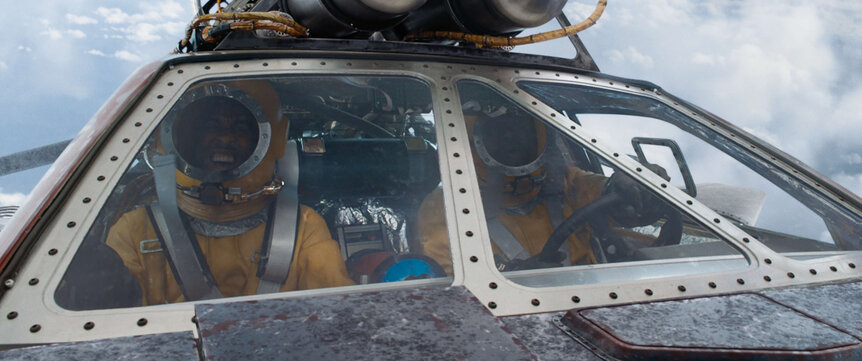Create a free profile to get unlimited access to exclusive videos, sweepstakes, and more!
Could You Really Launch a Car Into Space, Like in F9? The Science Behind the Fiction
Launching a Pontiac Fiero into space is no small task.

No one has ever accused the Fast and Furious franchise of realism. While the series began rooted in the real world with its first film, it’s drifted pretty hard into increasingly fantastical adventures. In the penultimate chapter of the franchise, F9, two characters way more than a quarter mile straight up into outer space.
It’s been a long-running joke among fans — and among the creators — that the Family would eventually end up in space. In an interview with The Hollywood Reporter, director Justin Lin stated he’s been playing with the idea of going to space for years, waiting to find the right emotional arc to justify the move. In F9, he found it.
While taking the characters to space in a tricked-out Pontiac Fiero started as a joke, according to Lin it’s actually one of the more grounded (pun intended) action sequences in the film, or the franchise. In that same THR interview, Lin mentions talking with scientists about “fuel and physics,” he also apparently consulted extensively with NASA scientists in order to get the sequence just right, or at least as close as can be expected for a Fast flick.
RELATED: Stream Fast & Furious 9 right now on Peacock
If there’s anyone we can trust to know about spacefaring, it’s NASA, but let’s consider what it might take to get a Fiero into orbit and return its crew safely back to Earth.
Getting There
Getting into orbit isn’t all that difficult, relatively speaking. We’ve been doing it more-or-less consistently for over 50 years, with payloads substantially larger than a Pontiac Fiero. Thousands of satellites have been launched into orbit successfully, with more launching all the time.
Government entities, as well as private companies, launch regularly, to the point that the activity has become sadly mundane. The Fiero wouldn’t even be the first car in space. Depending on your definition, several cars have left our planet for orbit or for other worlds. The Apollo program used drivable lunar rovers, beginning with Apollo 15. Although, they tapped out at a blistering 8 miles per hour (13 kph). Not exactly furious.
The Mars rovers can also be thought of as cars, though they are piloted remotely from Earth. Still, both Curiosity and Perseverance are car-sized objects, about the size of an average SUV. And who could forget Elon Musk launching a Tesla Roadster into space aboard SpaceX’s Falcon Heavy? While the ethics of launching a car into space, purely for the cool factor, are questionable at best, it does represent the first and (for now) only example of what we might consider a recognizable automobile in orbit.
In short, getting a car into space is not only possible, it’s been done. Check. But the situation presented in F9 is a little different. We’re not talking about a car as part of a payload on a large rocket-assisted mission. We’re talking about a car as the launch vehicle.
The Fiero has a couple of things working in its favor. First, it’s a small payload. The weight of the car, even with modifications and reinforcements, is lighter than a typical launch payload. Second, in the movie, it's launched from the air, not from a launchpad on the ground.
The primary element working against the Fiero launch is the size of its rocket engine. You need about 11,000 meters per second of velocity to escape Earth’s gravity and that requires a lot of fuel. It’s the reason relatively small payloads are typically attached to comparatively large rockets. While we don’t have the benefit of concrete numbers, judging by the size Fiero’s rocket engine, launching from the air rather than the ground was the only possible option.
Air to orbit launches involve attaching a payload to an aircraft and taking it to altitude. The benefits of such a launch include reducing the distance to orbit as well as the density of the atmosphere. Overall, it means a lower fuel requirement so something like a Fiero could potentially get to orbit with a smaller engine.
Despite all of this, whether or not the Fiero could get to orbit with the type of engine they were using remains an open question.
Getting Back... Alive
Getting to orbit is only the first part of a successful mission. Once there, you have to survive long enough to accomplish your objective and, hopefully, return home. Assuming the Fiero makes its way off Earth, could it be equipped to keep its crew of two alive?
There are some essential things to consider with any orbital craft. It needs to hold an atmosphere, and it needs to be able to re-enter the atmosphere without burning up.
The average Fiero (or any consumer automobile) isn’t equipped to hold an atmosphere. Driving on the surface of Earth, there’s no reason to be air tight. In fact, having gas exchange is pretty important. If your car was air-tight, you might be in trouble on any extended road trip. Your car is designed to bring air in from the outside and, even where there is no intentional design, air comes in via insufficient seals. On Earth, this prevents riders from suffocating, but if you’re taking your car to space, you’ll want to shore those gaps up. Windows, doors, vents — anything that can open, and anywhere there’s a separation — should be sealed.
Importantly, seals that might be sufficient on Earth might not hold up in space. Spacecrafts typically have redundant systems. Extra rivets, extra seals, extra shields are the name of the game.
Even on the space station, a well-established space-based craft, leaks happen. Seals fail and micrometeoroids are a concern. Small pieces of debris traveling at high speeds can puncture crafts and leak air into the void. On something like the space station, this can be a minor problem, as far as these things go, because there's an excess of oxygen able to make up for the loss. In a small craft, like a Fiero, this would be a bigger problem. This brings us to the problem of shielding.
The entirety of the craft would need to be capable of protecting its crew from the dangers of space. Standard windows wouldn’t be sufficient. A micrometeoroid through a typical car window would be catastrophic and re-entry pressures would pose a problem. Speaking of re-entry…
Crafts come through the atmosphere at particular angles. Too shallow and they might bounce off the atmosphere like a skipped rock. Too deep and the might burn up. Spacecraft come in at seven kilometers a second, generating heat in excess of 1,600 degrees Celsius. Assuming the Fiero came in at the right angle, it would still need to be reinforced with heat shielding in order to deal with the friction of coming home.
In the end, while modifying an old car for space travel might be technically possible, it’s probably not the best strategy for getting to orbit and coming home.
Looks pretty cool, though.
Originally published Jun 30, 2021.



























